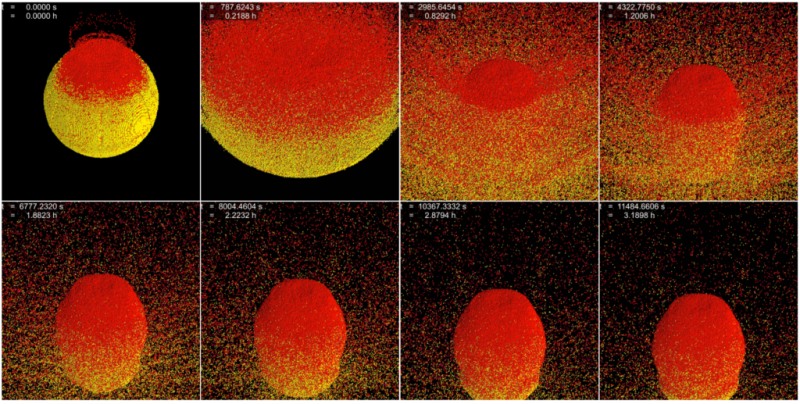Help EarthSky keep going! Please donate what you can to our annual crowd-funding campaign.
In recent decades, astronomers have become increasingly aware that asteroids and comets do sometimes strike Earth. Funding has increased for studies in which our skies are scanned for asteroids, which is the main reason we hear so often nowadays about asteroids sweeping relatively near the Earth. What’s more, astronomers have met to discuss what might happen if we found an asteroid headed our way. Popular books and movies have taken up this theme, too, with the idea we might send spacecraft to the asteroid to blow it up. But – according to a new study from Johns Hopkins University – blowing up an asteroid might not be easy.
These scientists used a new understanding of how rocks fracture, and a new computer modeling method, to simulate asteroid collisions. Charles El Mir, a recent Ph.D. graduate from Johns Hopkins University’s Department of Mechanical Engineering and the paper’s first author, commented in a statement:
We used to believe that the larger the object, the more easily it would break, because bigger objects are more likely to have flaws. Our findings, however, show that asteroids are stronger than we used to think and require more energy to be completely shattered.
These scientists’ findings will be published in the March 15, 2019, print issue of the peer-reviewed journal Icarus (preprint here).
They said their work can:
… aid in the creation of asteroid impact and deflection strategies, increase understanding of solar system formation and help design asteroid mining efforts.

The statement from Johns Hopkins explained:
Researchers understand physical materials like rocks at a laboratory scale (about the size of your fist), but it has been difficult to translate this understanding to city-size objects like asteroids. In the early 2000s, a different research team created a computer model into which they input various factors such as mass, temperature, and material brittleness, and simulated an asteroid about a kilometer (.6 mile) in diameter striking head-on into a 15-mile (25-km) diameter target asteroid at an impact velocity of 3 miles (5 km) per second. Their results suggested that the target asteroid would be completely destroyed by the impact.
In the new study, El Mir and his colleagues, K. T. Ramesh, director of the Hopkins Extreme Materials Institute and Derek Richardson, professor of astronomy at the University of Maryland, entered the same scenario into a new computer model called the Tonge-Ramesh model, which accounts for the more detailed, smaller-scale processes that occur during an asteroid collision. Previous models did not properly account for the limited speed of cracks in the asteroids.
The simulation was separated into two phases: a short-timescale fragmentation phase and a long-timescale gravitational reaccumulation phase. The first phase considered the processes that begin immediately after an asteroid is hit, processes that occur within fractions of a second.
The second, long-timescale phase considers the effect of gravity on the pieces that fly off the asteroid’s surface after the impact, with gravitational reaccumulation occurring over many hours after impact.
In the first phase, after the asteroid was hit, millions of cracks formed and rippled throughout the asteroid, parts of the asteroid flowed like sand, and a crater was created. This phase of the model examined the individual cracks and predicted overall patterns of how those cracks propagate.
The new model showed that the entire asteroid is not broken by the impact, unlike what was previously thought. Instead, the impacted asteroid had a large damaged core that then exerted a strong gravitational pull on the fragments in the second phase of the simulation.
The research team found that the end result of the impact was not just a ‘rubble pile’ – a collection of weak fragments loosely held together by gravity. Instead, the impacted asteroid retained significant strength because it had not cracked completely, indicating that more energy would be needed to destroy asteroids. Meanwhile, the damaged fragments were now redistributed over the large core, providing guidance to those who might want to mine asteroids during future space ventures.
El Mir commented:
Our question was, how much energy does it take to actually destroy an asteroid and break it into pieces?
It may sound like science fiction but a great deal of research considers asteroid collisions. For example, if there’s an asteroid coming at Earth, are we better off breaking it into small pieces, or nudging it to go a different direction? And if the latter, how much force should we hit it with to move it away without causing it to break? These are actual questions under consideration.
Ramesh added:
We are impacted fairly often by small asteroids, such as in the Chelyabinsk event a few years ago. It is only a matter of time before these questions go from being academic to defining our response to a major threat. We need to have a good idea of what we should do when that time comes – and scientific efforts like this one are critical to help us make those decisions.
Bottom line: Researchers at Johns Hopkins employed a new understanding of how rocks fracture, and a new computer modeling method, to simulate asteroid collisions. They found that asteroids are harder to shatter than previously believed.











